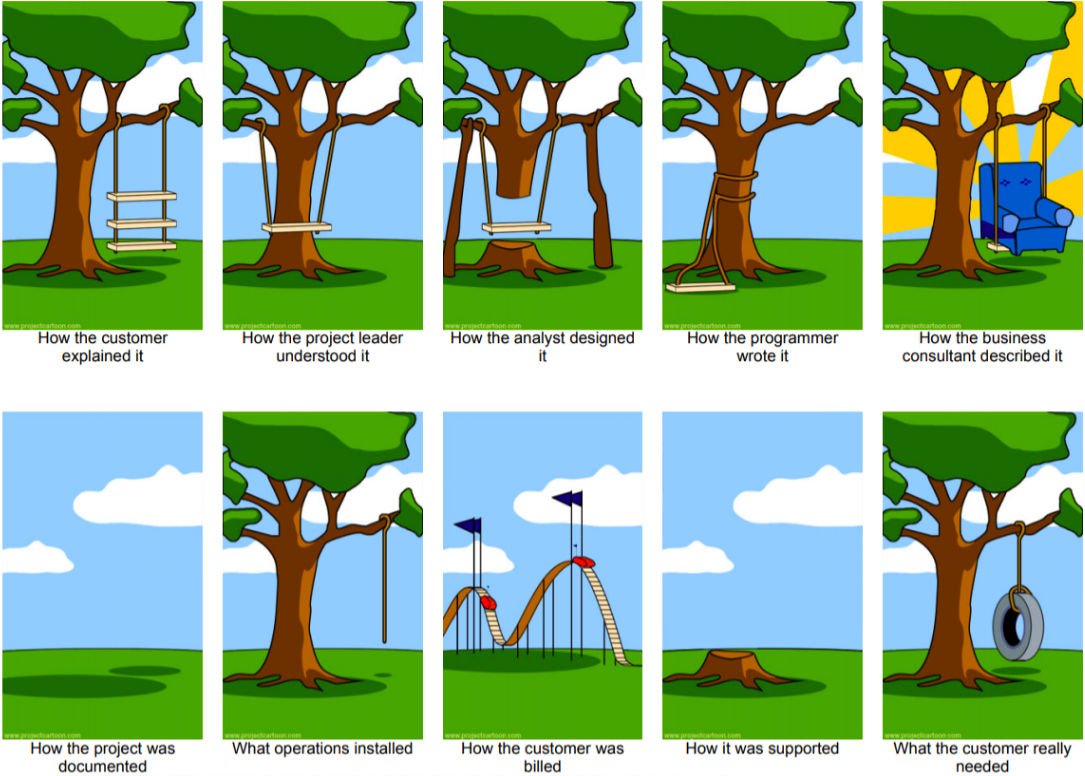You have 1 article left to read this month before you need to register a free LeadDev.com account.
Are your engineering teams engaging with customers directly?
There’s a standard (and very simplistic) model for the relationship between product, engineering, and customers:
1. product speaks to the customer;
2.product brings back the requirements to engineering;
3.engineering builds the product;
4.product helps position and sell the product to the customer.
In this model, customers and engineering don’t appear in the same line. But this is a missed opportunity! Here I’m sharing why bringing engineering to the (virtual) customer table leads to more satisfied customers, a more engaged engineering org, and greater company success.
The benefits of bringing together engineering and customers
Building empathy
From an engineering perspective, the first and arguably the most important benefit is that it strengthens the level of empathy developers have with the customer. ‘The customer’ can very easily become an abstract concept – a persona (or set of personas) rather than living, breathing people looking for solutions to their problems.
Humans empathize with other humans, not personas. People want to help other people and when an engineer listens and interacts with a customer directly, it helps create a personal bond. Whenever I’ve brought engineering leads in to hear customers talk about their need for a new feature or expedited bug fix, the discussions afterward haven’t been around roadmap trade-offs or schedule impacts but rather how we can quickly ‘do right’ by the customer.
Aligning on product vision
Bringing customers and engineering together also helps reduce the potential for misunderstandings and lost-in-translation errors. We’ve all experienced some version of the famous cartoon below.

As information moves through an enterprise, each organizational hop ‘clarifies’ the customer need until it’s no longer recognizable.
Many enterprise customers identify with the above problem as they often deal with it themselves. They welcome opportunities to remove some hops and interact directly with the product builders.
When customers speak with engineering, they feel they’re getting ‘the truth’ of what’s possible without the filter often added by sales or product teams. For highly technically customers, the opportunity to deep-dive with engineering is always welcomed as they can learn about the intricacies of the product.
I was once in a situation where the customer was convinced we were rejecting their request for a complex feature (an in-state software upgrade) in our legacy networking product line because we didn’t want to prioritize the work. They wouldn’t accept that the old product line was simply technically incapable of supporting the feature as requested, namely, a zero-downtime upgrade capability. However, after meeting with our engineering team, the customer understood, however reluctantly, the infeasibility of what they were asking for. The customer was still unhappy but at least the discussion moved on to alternative approaches. Providing the customer unfiltered access to engineering wasn’t just helpful but absolutely critical.
Building trust between engineering and product
Finally, involving engineering in customer discussions clearly manifests trust between product management and engineering.
If you’re a product manager, the most important asset you have is the trust you’ve built with your various teams, including engineering, marketing, sales, and more. Product managers don’t build the product; they don’t sell it; they don’t support it. Successful product managers help create the shared vision and orchestrate the teams towards delivery and growth. This can only happen when there is confidence between and amongst all parties.
Things will not go as planned: there will be delays, there will be bugs, and customer uptake will be slow. This list goes on. Without trust, these small bumps can very easily spiral into loss of momentum and finger-pointing. With trust, there will acceptance that sh*t happens and we will overcome the issues together.
By bringing together engineering and customers, product managers can build better relationships with engineering, build that essential trust, and grow their level of influence.
Debunking concerns around bringing together engineering and customers
Despite the clear benefits to be gained from encouraging customer-engineering engagement, this model isn’t embraced as widely as it should be. There are two main reasons for this:
- Perhaps the most common rationale is that customer engagement can be distracting and that it defocuses engineers. Meeting with customers takes away time from an engineer’s actual work. I find this response illogical how can understanding customer needs not be beneficial to all? Yes, we don’t want folks to run off and act on what was discussed without consultation around relative priorities and other deliverables but wanting to address customer needs is an unvarnished positive.
- A related(and also weak) concern is that engineers will share too much information and contradict the previous positioning by product management or sales. But this is nothing a simple pre-customer meeting briefing can’t address. Senior engineers can understand the importance of maintaining a consistent message while also engaging in serious technical discussions.
Both these concerns are emblematic of culture. Some organizations have clear delineations of roles and responsibilities. Those barriers may be strong and difficult to overcome. However, a modern enterprise increasingly no longer has hardened functional silos. Thus there’s a willingness, and even eagerness, for individuals to participate in all aspects of solving customer needs.
Reflections
Championing and encouraging judicious customer-engineering engagement provides benefits along multiple dimensions. It increases customer trust, reduces translation error, and increases organizational cooperation. By giving engineering a full seat at the customer meeting table, customer satisfaction is increased from both a product and support perspective. Seems like a no-brainer? That’s because it is.



